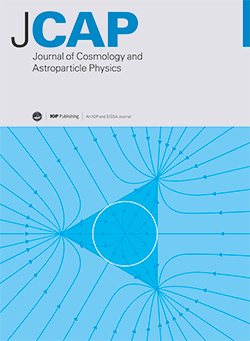来自一般弹跳宇宙学的原始全双光谱
IF 5.3
2区 物理与天体物理
Q1 ASTRONOMY & ASTROPHYSICS
Journal of Cosmology and Astroparticle Physics
Pub Date : 2025-06-26
DOI:10.1088/1475-7516/2025/06/063
引用次数: 0
摘要
原始非高斯量是测试早期宇宙场景的关键量。本文计算了一般弹跳模型在收缩阶段产生的标量微扰和张量微扰的全双谱。一般弹跳模型由两个分支组成:一个分支从振幅在超视界尺度上恒定的扰动中实现标量和张量的尺度不变功率谱,如德西特暴涨;另一个分支从振幅在超视界尺度上增长的扰动中实现尺度不变功率谱,如物质弹跳宇宙学。我们研究了由这两个分支的尺度不变标量和张量摄动引起的自双谱和交叉双谱。我们研究了非高斯的振幅和形状,并发现在等边和压缩动量三角形构型中两个分支之间的差异。特别地,超视界扰动守恒的一个分支再现了所谓的马尔达西纳一致性关系。通过考察摄动条件并考虑当前对原始非高斯的观测约束,我们还找到了一个理论约束和观测约束同时满足的可行参数空间。本文章由计算机程序翻译,如有差异,请以英文原文为准。
Primordial full bispectra from the general bounce cosmology
Primordial non-Gaussianities are key quantities to test early universe scenarios. In this paper, we compute full bispectra of scalar and tensor perturbations generated during a contracting phase in a general bounce model. The general bounce model consists of two branches: one realizes scale-invariant scalar and tensor power spectra from perturbations whose amplitudes become constant on superhorizon scales, as in de Sitter inflation, while the other realizes scale-invariant power spectra from perturbations whose amplitudes grow on superhorizon scales, as in matter bounce cosmology. We study the auto- and cross-bispectra originating from the scale-invariant scalar and tensor perturbations in these two branches. We investigate the amplitudes and shapes of non-Gaussianities and find that the differences between the two branches manifest for equilateral and squeezed momentum triangle configurations. In particular, one of the branches in which the superhorizon perturbations are conserved reproduces the so-called Maldacena's consistency relation. By examining perturbativity conditions and considering current observational constraints on primordial non-Gaussianities, we also find a viable parameter space in which both theoretical and observational constraints are satisfied simultaneously.
求助全文
通过发布文献求助,成功后即可免费获取论文全文。
去求助
来源期刊

Journal of Cosmology and Astroparticle Physics
地学天文-天文与天体物理
CiteScore
10.20
自引率
23.40%
发文量
632
审稿时长
1 months
期刊介绍:
Journal of Cosmology and Astroparticle Physics (JCAP) encompasses theoretical, observational and experimental areas as well as computation and simulation. The journal covers the latest developments in the theory of all fundamental interactions and their cosmological implications (e.g. M-theory and cosmology, brane cosmology). JCAP''s coverage also includes topics such as formation, dynamics and clustering of galaxies, pre-galactic star formation, x-ray astronomy, radio astronomy, gravitational lensing, active galactic nuclei, intergalactic and interstellar matter.
 求助内容:
求助内容: 应助结果提醒方式:
应助结果提醒方式:


